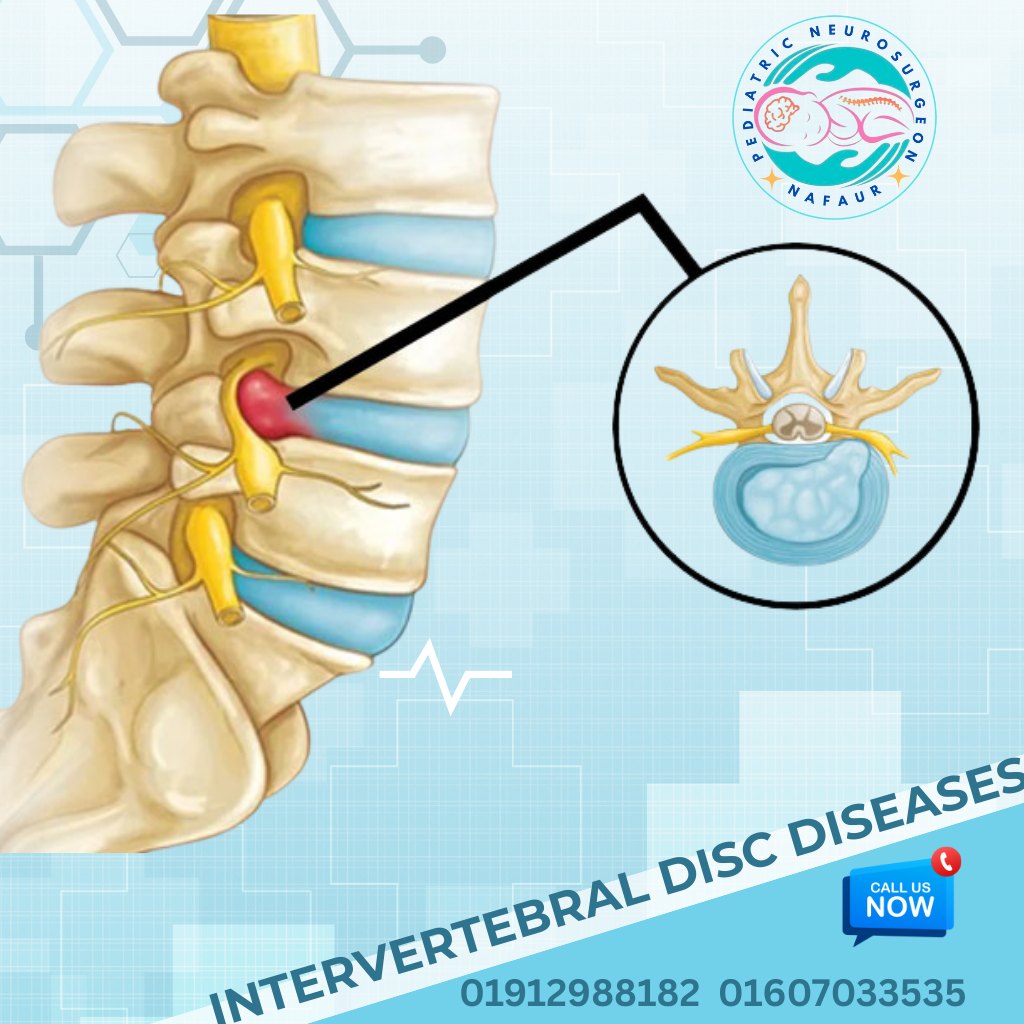Intervertebral Disc Diseases
Intervertebral Disc Diseases
Pediatric Intervertebral Disc Diseases (IVDD) refer to abnormalities or damage in the cartilaginous discs located between the vertebrae of a child’s spine. These discs function as shock absorbers and maintain flexibility and alignment of the spine. When diseased or herniated, they can cause pain, nerve compression, spinal deformities, and in severe cases, neurological deficits. Though intervertebral disc disorders are more commonly seen in adults, children and adolescents in Bangladesh are increasingly being diagnosed with disc problems due to trauma, poor posture, spinal deformities, sedentary lifestyle, and congenital factors. With early diagnosis and intervention by experts like Dr. Md. Nafaur Rahman, these conditions can be effectively managed with non-surgical or minimally invasive surgical techniques. 🧬 Causes of Intervertebral Disc Disease in Children (Bangladesh Context) While pediatric disc disease is relatively rare, certain risk factors have been identified in the Bangladeshi population: 🧱 Traumatic injuries – from falls, school accidents, or road traffic incidents 📚 Prolonged poor posture – common among students carrying heavy schoolbags or sitting improperly for long periods 🏏 Sports injuries – from cricket, football, gymnastics, and martial arts 🧬 Congenital spine anomalies – like scoliosis or kyphosis that increase disc pressure 🦴 Nutritional deficiencies – especially vitamin D and calcium in undernourished children 🪑 Sedentary lifestyle & obesity – increasingly seen in urban children due to screen addiction 🧔 Repeated spinal strain – in children involved in early labor or lifting 🧠 Common Pediatric Disc Disorders 🔸 1. Disc Herniation (Slipped Disc) Nucleus pulposus pushes through the annulus fibrosus May compress spinal nerves causing pain or weakness Lumbar herniation is most common in pediatric cases 🔸 2. Degenerative Disc Disease Disc wear-and-tear at a young age Often related to congenital weakness, trauma, or malnutrition Causes back pain and stiffness, especially in teens 🔸 3. Scheuermann's Disease A condition where discs and vertebrae grow unevenly, causing kyphosis Usually presents in adolescents with poor posture and back pain 🔸 4. Traumatic Disc Injuries Sudden disc rupture due to impact or lifting heavy objects Common in accidents or sports-related trauma ⚠️ Symptoms of Pediatric Intervertebral Disc Problems Signs that may indicate disc-related issues in children include: Persistent back or neck pain Pain radiating to arms or legs (radiculopathy) Tingling or numbness in limbs Stiffness after waking or sitting for long periods Visible posture changes (hunched back, slouched shoulders) Inability to carry schoolbags or participate in sports Sudden loss of bladder or bowel control (in severe cases) “Even one overlooked complaint of back pain in a child can evolve into lifelong disability. Early evaluation saves futures.” — Dr. Md. Nafaur Rahman 🏥 Diagnostic Approach at NINS & BP Neurocare Dr. Nafaur Rahman’s team provides thorough diagnostics using child-appropriate, radiation-safe methods: MRI of the spine – Best for soft tissue visualization, disc bulge, and nerve root compression X-rays (standing and dynamic) – To assess alignment and spinal curvature CT Scan (if needed) – For complex or trauma-related bony anatomy Neurological Examination – Checking reflexes, muscle strength, and sensation Growth and postural assessment – Especially in adolescents All imaging and clinical evaluations are tailored to the child’s age, symptoms, and activity level. 🛠️ Treatment Options for Pediatric Disc Disorders ✅ Non-Surgical Management (For Mild to Moderate Cases): Pain relief – NSAIDs and muscle relaxants (age-specific doses) Spinal bracing – For posture correction and scoliosis/kyphosis management Physiotherapy – Strengthening core muscles and spinal support Posture training & ergonomic guidance – Especially for students Nutritional counseling – To address bone and disc health Most mild to moderate disc conditions improve with 3–6 months of conservative treatment. 🧠 Surgical Intervention (For Severe or Refractory Cases): Dr. Nafaur Rahman performs advanced pediatric spine surgeries when conservative methods fail, or when there is: Progressive nerve compression Large or calcified disc herniation Development of spinal instability or deformity Neurological deficits (weakness, loss of bladder control) Surgical Techniques Include: Microdiscectomy – Removal of herniated disc under magnification Endoscopic Discectomy – Minimally invasive and scar-minimizing Spinal Fusion – In cases of instability Correction of kyphosis – In Scheuermann’s disease or disc degeneration Each surgery is planned using age-appropriate spinal hardware and growth-sparing methods. 🔁 Recovery & Rehabilitation Following surgery or bracing, children undergo: Structured spinal physiotherapy Return-to-school plans with postural support Avoidance of sports or heavy lifting for several months Regular imaging follow-up Family counseling for home ergonomics and exercise continuation 🌍 Pediatric Disc Disease in Bangladesh: Unique Challenges Issues: 🚫 Misconception that children don’t suffer from “back problems” ⏳ Delayed medical visits due to school or rural access barriers 💼 Schoolbags that are too heavy and improperly worn 🪑 Poor classroom ergonomics or lack of awareness 🏥 Limited access to pediatric MRI in non-urban hospitals Dr. Nafaur Rahman’s Solutions: Runs school-based spine health campaigns Advocates for backpack weight regulations and classroom posture training Works with community doctors to improve early detection Provides affordable, minimally invasive care options for families Collaborates with rehab specialists for long-term posture correction 👨⚕️ Why Trust Dr. Md. Nafaur Rahman? 🧠 Renowned in Bangladesh for pediatric spinal neurosurgery 🏥 Practices at NINS, the top public neurology institute 🧒 Expert in minimally invasive disc surgeries for children 💬 Approachable and compassionate with both child and family 📈 Excellent outcomes in disc-related nerve recovery and posture correction 📞 Contact for Pediatric Disc Disorder Assessment or Surgery Dr. Md. Nafaur Rahman Assistant Professor, Pediatric Neurosurgery, NINS Chief Consultant, Bangladesh Paediatric Neurocare Centre 📱 For Serial/Appointment: 📞 01912988182 | 📞 01607033535 🌐 Website: www.neurosurgeonnafaur.com
Common Pediatric Disc Disorders










